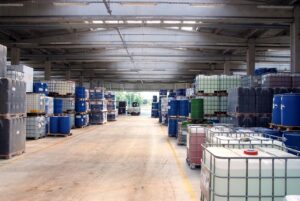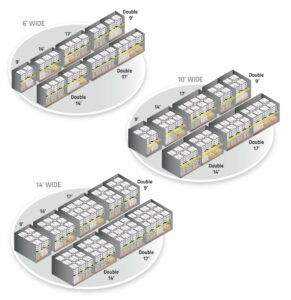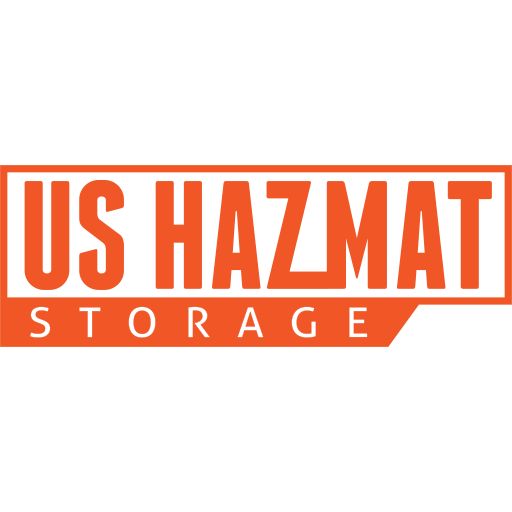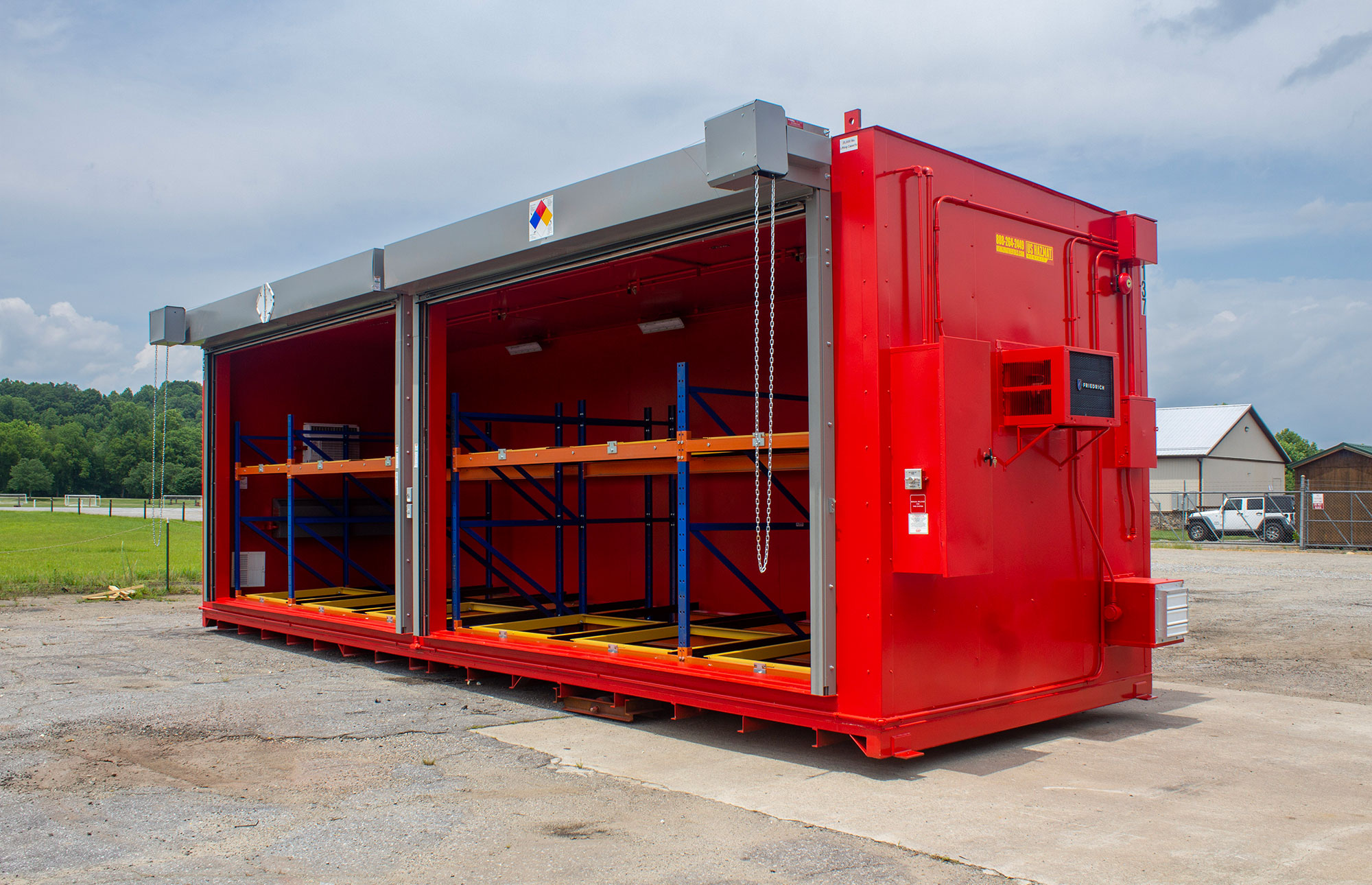Storing larger volumes of hazardous materials is a logistical challenge for many manufacturers. Where will you fit chemical drums and IBC totes? How will you safely store dangerous chemicals without interrupting facility operations? Timely assessment of these questions ensures workplace compliance and employees’ safety. While considering inventory needs for raw materials and building supplies, special accommodations should be made for precursor chemicals. Flammable and combustible chemicals should never be stored with workplace equipment and supplies. Although OSHA doesn’t specify safety requirements for smaller chemical stockpiles, chemical storage lockers are necessary for larger volumes of flammable materials.
How Much is Too Much?

OSHA says no more than 25 gallons of flammable or combustible liquids may be stored in a room outside of an approved storage cabinet. Additionally, OSHA requires no more than 60 gallons of flammable liquid (flashpoint below 140 degrees F) or 120 gallons of combustible (flashpoint at or above 140 degrees F) can be stored in a single chemical storage container or warehouse. OSHA also requires rated storage safety cabinets when possible. Furthermore, any Category I, II, or III flammable liquids should be kept in closed containers when not in use. NFPA 30 warns against storing more than 120 gallons of Class IB, Class IC, Class II, or Class III liquids in containers. Finally, the NFPA caps any combination of Class IB, IC, or IIIA liquids in metal tanks or metal IBC containers – each not exceeding 793 gallons – at 1,585 total liquid gallons.
Acceptable Hazardous Materials Storage Containers

Chemical storage has changed over the years. Although steel-welded drums are an industry go-to for compliant chemical storage, more efficient and affordable options abound. Caged IBC totes provide greater flexibility for long-term storage and material dispensing than steel drums. They are also easier to stack (via forklift) and have less carbon footprint while meeting NFPA 30 recommendations and OSHA standards. Every industry, from food manufacturing and farming to pharmaceuticals and construction, routinely uses IBC tote containment systems. While the list of acceptable chemicals for IBC tote storage is extensive, we strongly advise against storing ethanol and other solvents in plastic IBC totes due to their plastic composition. However, IBC totes can safely store pesticides, fungicides, and fertilizers.
Stacking Chemical Drums and IBC Totes
Companies should store steel drums and IBC totes in a cool, well-ventilated area away from egresses and vulnerable equipment and personnel. Steel drum stacking should never exceed a specific gravity of 1.5. Material handlers should also avoid drum overhangs on stackable pallets. OSHA regulations prohibit pressurizing steel drums or IBC totes for content removal. Furthermore, avoid stacking IBC totes that are more than two to three units high. Proper labeling of chemical drums and containers prevents misidentification and the improper mixing of incompatible materials. All chemical drums and containers should be placed on an even surface, preventing tipping.
Pallet Size

Plastic pallets are a great tool for stacking metal and plastic drums containing dangerous chemicals. Pallets should never exceed 48′ x 48′ dimensions. Moreover, OSHA regulations warn against pallet stacking greater than 15 feet high. Many caged IBC tote systems have a built-in pallet, streamlining retrieval and storage with a forklift.
Storage Locker Requirements
NFPA 30 – the industry standard for handling and storing flammable liquids – requires all metal storage cabinets and lockers to be composed of 18 gauge steel from top to bottom. Furthermore, storage cabinets and lockers must be welded, riveted, or tight to prevent leaks and environmental contamination. A three-latch door arrangement is also required for steel cabinets and lockers. The door sill of the container should be raised at least two inches above the bottom to retain spilled liquid inside the storage locker.
Ventilation Prevents Fires While Protecting Products
Although NFPA 30 doesn’t necessitate ventilation, we highly recommend this option for all chemical storage lockers housing flammable liquids. Mechanical ventilation prevents the toxic accumulation of dangerous fumes and vapors that could lead to flashover events. For ventilated chemical storage cabinets, Section 9.5 of NFPA 30 says vents should “duct directly to a safe location outdoors or to a treatment device designed to control volatile organic compounds (VOCs) and ignitable vapors.” Vent openings should be sealed if the storage cabinet is unventilated, according to the NFPA.
Fire Suppression for Chemical Stockpiles
Fire suppression further protects large volumes of flammable and combustible liquids. Although not standard, onsite fire suppression prevents smaller fires from becoming more significant chemical incidents, jeopardizing your workforce and the communities you serve. Our hazmat warehouse’s optional fire suppression uses an overhead piping system to douse flames with a dry-chemical agent instantaneously.
Wide-Swinging Doors and Pushed-Back Shelving
Accessibility and compliant chemical protection are not mutually exclusive. Wide-swinging doors and pushed back shelving allows for the easy storage and removal of drum pallets with a forklift or hand truck. Furthermore, larger egresses allow for the better organization and inventorying of hazardous materials, enhancing company logistics.
Hazardous Materials Safety Data Sheets
A Safety Data Sheet exists for every hazardous chemical used in industrial settings. An SDS contains all pertinent information about a specific chemical compound, including physical properties, safety hazards, storage guidelines, first aid measures, and incompatible materials. Each safety data sheet is unique and specific to the listed chemical. For example, a chlorine SDS is separate from an ethanol SDS. Safety Data Sheets should be readily available for each employee handling dangerous chemicals. Furthermore, safety data sheets assist in safe and compliant chemical storage.
Spill Containment

Following NFPA and OSHA storage regulations also prevent accidental spills and pollution. Failure to properly secure hazardous chemicals from environmental incursions leads to EPA civil penalties and fines. Moreover, manufacturers must protect the communities they serve. Each U.S. Hazmat Storage chemical locker is equipped with a secondary spill sump containment that sits beneath a steel-grated floor. During a spill, the dangerous chemical passes through the flooring into a sump until extraction. Our chemical storage lockers meet all NFPA 30 recommendations and OSHA regulations for the compliant storage of large volumes of hazardous materials. Moreover, we can safely protect your employees, vulnerable equipment, and the communities you serve with affordable storage options. We offer compliant protection for various-sized chemical stockpiles. Contact us today for a free quote and consultation.


